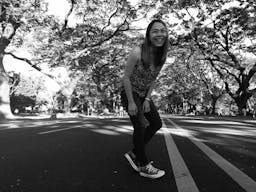My Journey
Apr 28, 2022
Story
My journey in women’s rights advocacy
I grew up resenting that my brother is not required to do the dishes because, as my father puts it, it’s a woman’s job.
I came from a province in the southern part of the Philippines. Born into a family with modest means, home taught me the values of responsibility and perseverance. Despite having only enough to make ends meet, my parents never turn their backs to any relatives or friends who needed help. Once, my mother’s nephew’s wife has given birth but they didn’t have any money to pay the hospital. My parents didn’t have any cash to spare at that time. So they pawned one of the household appliances and contributed the amount to pay the hospital bills. And it was at home that I learned the values of sharing and being there for others, as well as the grim realities of poverty.
My parents had a more impoverished life growing up. They are sons and daughters of farmers and fisherfolks, and grew up in a traditional and patriarchal culture. And that’s why in our family, my sister and I do the dishes and my brother fix broken furniture. And it was at home that I started to question the stereotypes prevailing between women and men.
Working hard to provide a better future for their children, my parents sent us to private primary and secondary schools. And in school were I ‘learned' through socialisation that it is ‘embarrassing' to be poor, I learned to resent inequality. When I got into the University, I became more aware of the growing inequalities in the society. I met women from different sectors, and learned about their lives and struggles. I became aware that women’s struggle go beyond the differences in gender. Oppression is also shaped by the economic and socio-cultural contexts of women.
Straight from university I joined Center for Women’s Resources where I worked in advocacy, research, and training. It was during my time with the center that I met more women and became inspired with their stories of struggle and commitment to change—the grandmothers who were comfort women during the Japanese Occupation in the Philippines; the peasant women who remain landless; the workers who are fighting for jobs and decent wages; the indigenous women who are being displaced by militarisation and mining; the young women who are survivors of rape; and the women who were promised jobs but ended up as prostitutes in the streets of Manila.
Three years into working full time, I took a break to pursue advance studies in development communication where I honed my knowledge and skills on how communication can be a tool for change. While enrolled full time, I tried to remain engaged in the advocacies for women as a volunteer for CWR, and even spearheaded the Move to Mob, a support to the One Billion Rising campaign, in the campus.
In 2013, Typhoon Haiyan hit the central region of the country and devastated thousands of women, children, and their families. In 2014, I joined an international humanitarian organisation and developed a participatory project to raise children’s voices in the recovery of their community though creative media and the internet. I also had the chance to join the Nepal Earthquake Response to kick-off the same project with the affected children. Through my experience in the humanitarian response, I gained more skills and insights on the significance of the participation of the marginalised groups, including women and girls, in shaping the future of their communities.
Currently working on an academic research, I am in the pursuit in deepening my understanding and practice on women and girl’s meaningful participation for social change. Despite the advances that the women’s movement has gained in the Philippines, women remain among the poorest sectors, and gender-based discrimination and violence remain prevalent.
As i've learned through my experience and interaction with women and girls in the communities, theirconfidence and ability to form and express viewpoints should be developed to support their capacity to participate.Women and girls from marginalised sectors have their own voices, but are often unheard because they are relegated a lower status in society. It is time to see and hear their stories and struggles, from their own eyes and voices. Currently I am involved with CWR’s Advocates for Women’s Empowerment (AWE) where I continue my involvement in raising voices of women. I hope to contribute to the empowerment of women and girls, especially in extremely difficult circumstances such as those caught in conflict and affected by disasters, by building their capacities to tell their stories using digital communications. I want to pursue a campaign for AWE that involves building the capacities of the Lumads, or indigenous women in the south where I came from, who are currently displaced from their communities as a result of militarisation. The Lumad women are historically deprived of access in education, and further marginalised because of the digital divide where they do not have access to modern communication technology. Though they have been constantly portrayed in media, but seldom are they the producers of these contents. Through a Photovoice approach, I hope to support them share their issues and highlight their active role in the struggle. A two-fold campaign, advocates will also be reached to amplify the voices of the Lumads in social media.
The campaign necessitates resources such as digital camera and instructional tools. Further, a strong grasp of visual and digital storytelling, and digital campaign is also essential to make the campaign effective, and this is what I hope to attain in the training and engagement with the World Pulse community.




